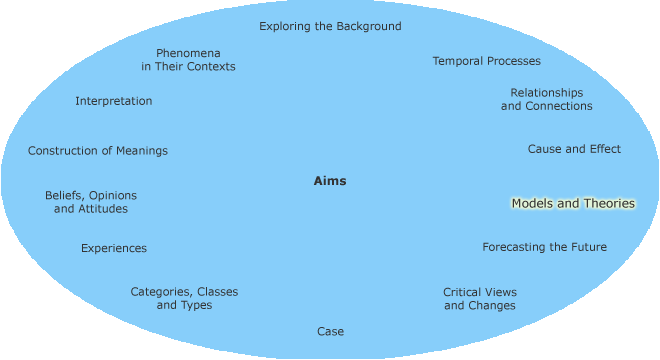Models and Theories

Humanistic researchers often form a theoretical model, concept hierarchy or theoretical point of view on the researched phenomena. Formation of a theory or a model may be based on criticism or development of existing theories or models. A common starting point for a research project which aims at forming theories or models is often in the observation that theoretical models, concepts or points of view on the chosen subject matter do not exist. Another starting point for the research is that the existing theories or theoretical concepts are inadequate or false.
Strategies
Research aiming to form a theoretical model, concept hierarchy or theoretical point of view by exploring concrete materials such as documents, interviews, images or objects can be defined as empirical research. The research may also be critical of existing theories with the aim of extending the theoretical discussion in order to form a new theoretical model, concept hierarchy or theoretical point of view (theoretical research). Researchers aiming to form theories or models use either the strategy of qualitative research or quantitative research.
If you intend to form theoretical models, concept hierarchies or theoretical points of view, you may use various research strategies, for example:
Critical research enables you to formulate critical theory.
Comparative research enables you to formulate a new theory.
Experimental research enables you to formulate either or both a theory and a model.
Data Collection
You can formulate theoretical models, concept hierarchies or theoretical points of view through different types of data collected by a variety of methods. You can use either data collected for previous research by another researcher (existing concrete materials) or collect / produce your own data during the research process.
You can use a variety of research strategies: Population research is suitable when the quantity of available data on a phenomenon is small. Sampling is suitable when the quantity of available data on a phenomenon is too large for you to analyse all of it. Random sampling enables you to select a small element without bias. Purposive sampling (goal-directed sampling) enables you to select samples that match the aim of the study.
When the aim of your research is to formulate theories, models or points of view, which do not exist on concrete phenomena you can collect data through interviews, questionnaires, observations, experiments or follow-up studies. When the aim of your research is to be critical, i.e. to comment on, criticize or renew existing theories, models or points of view, you should use data from the available topic specific literature.
Data Analysis
Both quantitative analysis and qualitative analysis methods are suitable for analysing the formation of models or theory.
Grounded Theory, a form of qualitative analysis, is often used in the formation of theories and models in cases when there is not any previous theory or when there exist only a little information on the phenomena.
Close reading, a form of qualitative analysis, is suitable for research, which aims to criticize, comment or renew the already existing theories or models.
Classification is suitable for research using either quantitative or qualitative research.
Philosophy in Science
Qualitative methods in the humanities are based on interpretivism. Views emphasizing interpretation in the formation of meanings and subjectivity in meaning-making processes are based on relativism.
Grouded Theory is based on hermeneutics.
Close reading of the data is based on hermeneutics.
Quantitative methods are based on positivism, which stresses the production of knowledge through exact measuring and use of numeral variables. Views, which emphasize the exactness and correctness of measured knowledge, obey the idea of realism. In realism, the knowledge is seen as objective.
